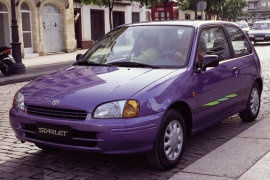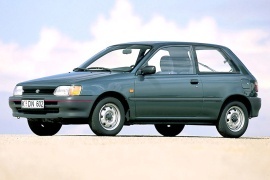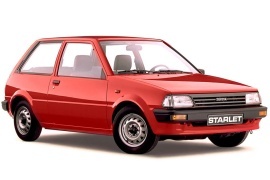
TOYOTA Starlet 3 Doors
Generations Timeline, Specs and Pictures

Toyota introduced the fifth generation of the Starlet in 1996, but the car didn’t confirm the same sales figures as its predecessors and, eventually, was withdrawn from the market three years later.
The small segment was very contested in the European market, and the local French or Italian carmakers were strong competitors for the Japanese brand. Still, Toyota had a strong reputation for dependable vehicles, and that should keep Starlet’s engine running for many years.
Maybe it was the design that didn’t fit the market. The Japanese carmaker tried an exciting design idea, with a sloped-down beltline over the doors. Its three-door version looked a bit sporty, but it was not a match for the European small-class hot-hatches, and its price was higher. At the front, the simple, curved headlights sported corner-mounted turns signals.
Inside, the straightforward design with hard plastic on the dash and door panels. On the center stack, the carmaker installed the ventilation control unit and a stereo cassette player. Its low-mounted seats led to less legroom for rear passengers but better headroom for the front ones. Depending on the options, the three-door Starlet offered power-windows at the front.
Under the hood, Toyota installed only one powertrain option, a 1.3-liter engine paired to a five-speed manual gearbox.

Designed as a low-budget vehicle, the Starlet made its appearance on the Japanese market in late 1989.
In March 1990, Toyota introduced it to the European market.
The Japanese carmaker worked hard to improve its products, and the Starlet was proof of commitment. It was better in any way, and it was available in a few body shapes, including a three-door hatchback. On the European market, it faced tough competition against the well-known Renault 5, Opel Corsa, or Peugeot 205, to name just a few.
At the front, the little Starlet featured a set of headlights and corner-mounted turn-signals that resembled the third generation of the Ford Fiesta. Unlike that one, the Japanese contender featured a black plastic grille with horizontal slats. Like any other three-door hatchback, it featured a set of longer ones to provide easier access for the rear-seat passengers. In the back, the windows were front-hinged and could have been opened via a pop-out system. Toyota installed a carefully designed dashboard with rounded shapes and a center stack for the audio and ventilation systems. It was the beginning of the biodesign era.
Under the hood, Toyota installed a wide range of engines from a small 75 hp unit up to a turbocharged, 135 hp version. The carmaker offered the car with a diesel engine for specific markets. An all-wheel-drive version of the Starlet was available, again, on distinct markets.

The little Starlet evolved from a sporty little coupe with rear-wheel drive to an econobox with front-wheel drive that raised the Japanese carmaker popularity due to its reliability.
In October 1984, Toyota introduced the third generation of the Starlet in Japan and unveiled it in the U.K. in February 1985. It was a complete makeover when compared to the previous, second-generation model. Toyota sold almost 800,000 units from the Starlet 70 until 1989 when it replaced it.
While it was just 20 mm (0.8 in) longer than its predecessor, it offered more interior room thanks to the front-wheel-drive solution. It was also 55 mm (2.2 in) wider and led to more room for the rear passengers. It was finally a supermini hatchback that could accommodate up to five adults inside. At the front, its flush to bodywork headlights and black plastic wrapped-around bumper was on par with the Volkswagen Polo or the Renault 5.
Inside, the third generation of the Starlet, also known as the Starlet 70, featured a minimalist design with a straight dashboard that sported a rectangular instrument cluster. The ventilation controls found their place on the front side of the dashboard, between the front occupants. There was no center stack nor center console, but the carmaker installed a push-button radio as standard. In the back, the bench was designed for three adults. Yet, it was primarily suitable for three kids.
Under the hood, Toyota introduced two new engines with three valves per cylinder. At steady speeds, it offered an incredible 4.5 l/100 km (52.3 mpg-US) fuel consumption for those times. That was achievable also thanks to the five-speed manual gearbox. For specific markets, Toyota added a turbocharged 1.3-liter engine as well.























































